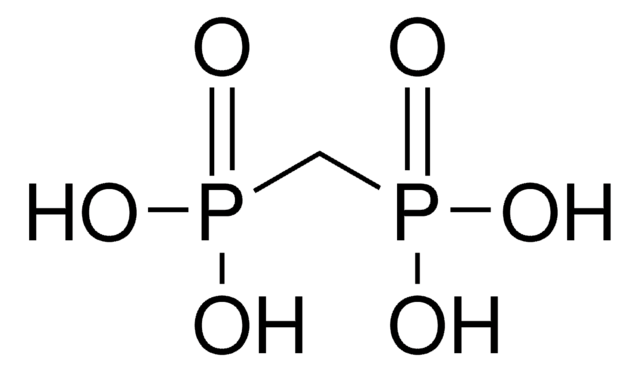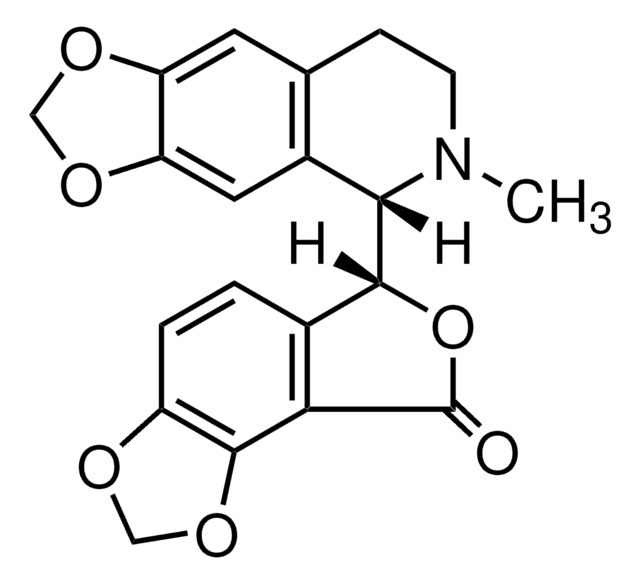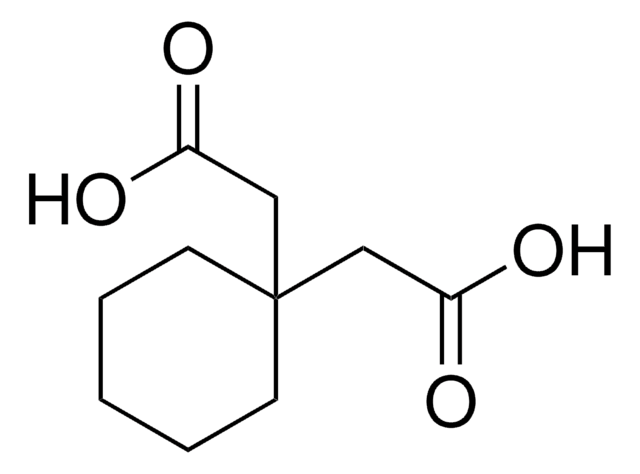38377
Abberior® STAR 580, NHS ester
for STED application
Autenticatiper visualizzare i prezzi riservati alla tua organizzazione & contrattuali
About This Item
Codice UNSPSC:
12352108
NACRES:
NA.32
Prodotti consigliati
Livello qualitativo
Saggio
≥70.0% (degree of coupling)
Solubilità
DMF: 1 mg/mL, clear
Fluorescenza
λex 583 nm; λem 605.0 nm±10 nm in PBS, pH 7
Temperatura di conservazione
−20°C
Descrizione generale
Abberior STAR 580 is the latest development for STED microscopy with a fluorescent dye in the orange regime. The dye can be excited from 550 to 580 nm. Abberior STAR 580 can substitute dyes like Atto™ 590/594 or AlexaFluor 584/594. The dye can most effectively be depleted in STED microscopy at 700 to 780 nm via e.g. a Ti:Sa laser or IR diodes.
Abberior STAR 580 is the dye of choice for orange fluorescence. Moreover, the dye is particularly designed and tested for 2-color STED microscopy in combination with Abberior STAR 635 using 2 separate STED wavelength. This offers the great advantage of using 2 regular (not featuring a long Stokes-shift) dyes, which are in general more photostable. Please see our 2-color dye section
Key features
Absorption Maximum, λmax:: 587 nm (PBS, pH 7.4; water)
584 nm (MeOH, aq. ACN)
Extinction Coefficient, ε(λmax):85,000 M-1cm-1 (PBS, pH 7.4)
Correction Factor, CF260 = ε260/εmax: 0.17 (PBS, pH 7.4; water)
Correction Factor, CF280 = ε280/εmax: 0.15 (MeOH, aq. ACN)
Fluorescence Maximum, λfl:607 nm (PBS, pH 7.4)
604 nm (MeOH, aq. ACN)
Recommended STED Wavelength, λSTED:700 - 780 nm
Fluorescence Quantum Yield, η:0.90 (PBS, pH 7.4)
Fluorescence Lifetime, τ: 3.5 ns (PBS, pH 7.4)
Abberior STAR 580 is the dye of choice for orange fluorescence. Moreover, the dye is particularly designed and tested for 2-color STED microscopy in combination with Abberior STAR 635 using 2 separate STED wavelength. This offers the great advantage of using 2 regular (not featuring a long Stokes-shift) dyes, which are in general more photostable. Please see our 2-color dye section
Key features
- Exceptionally bright orange fluorescent dye
- Ideal for STED microscopy at 700-775 nm
- 2-color labeling partner with STAR 635P for 2-color STED microscopy
Absorption Maximum, λmax:: 587 nm (PBS, pH 7.4; water)
584 nm (MeOH, aq. ACN)
Extinction Coefficient, ε(λmax):85,000 M-1cm-1 (PBS, pH 7.4)
Correction Factor, CF260 = ε260/εmax: 0.17 (PBS, pH 7.4; water)
Correction Factor, CF280 = ε280/εmax: 0.15 (MeOH, aq. ACN)
Fluorescence Maximum, λfl:607 nm (PBS, pH 7.4)
604 nm (MeOH, aq. ACN)
Recommended STED Wavelength, λSTED:700 - 780 nm
Fluorescence Quantum Yield, η:0.90 (PBS, pH 7.4)
Fluorescence Lifetime, τ: 3.5 ns (PBS, pH 7.4)
Applicazioni
Anti-Mouse IgG-Abberior® STAR 580 antibody produced in goat has been used for STED (stimulated emission depletion) microscopy in CA3 (Cornus Ammonis) sections. Abberior® STAR 580 conjugated with secondary antibody has been used for dual-color STED imaging of cultured hippocampal neurons.
Compatibilità
Designed and tested for fluorescent super-resolution microscopy
Altre note
Note legali
Atto is a trademark of Atto-Tec GmbH
abberior is a registered trademark of Abberior GmbH
Prodotti correlati
N° Catalogo
Descrizione
Determinazione del prezzo
Codice della classe di stoccaggio
11 - Combustible Solids
Classe di pericolosità dell'acqua (WGK)
WGK 3
Punto d’infiammabilità (°F)
Not applicable
Punto d’infiammabilità (°C)
Not applicable
Scegli una delle versioni più recenti:
Possiedi già questo prodotto?
I documenti relativi ai prodotti acquistati recentemente sono disponibili nell’Archivio dei documenti.
Daniela Ivanova et al.
The EMBO journal, 34(8), 1056-1077 (2015-02-06)
Persistent experience-driven adaptation of brain function is associated with alterations in gene expression patterns, resulting in structural and functional neuronal remodeling. How synaptic activity-in particular presynaptic performance-is coupled to gene expression in nucleus remains incompletely understood. Here, we report on
Pawel Fidzinski et al.
Nature communications, 6, 6254-6254 (2015-02-05)
KCNQ2 (Kv7.2) and KCNQ3 (Kv7.3) K(+) channels dampen neuronal excitability and their functional impairment may lead to epilepsy. Less is known about KCNQ5 (Kv7.5), which also displays wide expression in the brain. Here we show an unexpected role of KCNQ5
S W Hell et al.
Optics letters, 19(11), 780-782 (1994-06-01)
We propose a new type of scanning fluorescence microscope capable of resolving 35 nm in the far field. We overcome the diffraction resolution limit by employing stimulated emission to inhibit the fluorescence process in the outer regions of the excitation
Marcus Dyba et al.
Nature biotechnology, 21(11), 1303-1304 (2003-10-21)
We report immunofluorescence imaging with a spatial resolution well beyond the diffraction limit. An axial resolution of approximately 50 nm, corresponding to 1/16 of the irradiation wavelength of 793 nm, is achieved by stimulated emission depletion through opposing lenses. We
Tim Grotjohann et al.
Nature, 478(7368), 204-208 (2011-09-13)
Lens-based optical microscopy failed to discern fluorescent features closer than 200 nm for decades, but the recent breaking of the diffraction resolution barrier by sequentially switching the fluorescence capability of adjacent features on and off is making nanoscale imaging routine. Reported
Il team dei nostri ricercatori vanta grande esperienza in tutte le aree della ricerca quali Life Science, scienza dei materiali, sintesi chimica, cromatografia, discipline analitiche, ecc..
Contatta l'Assistenza Tecnica.





